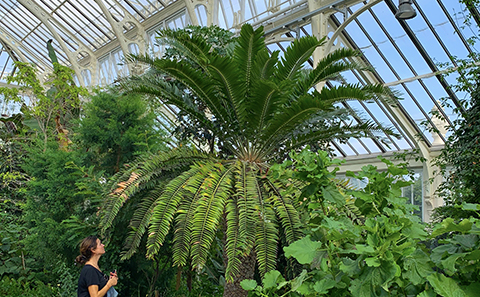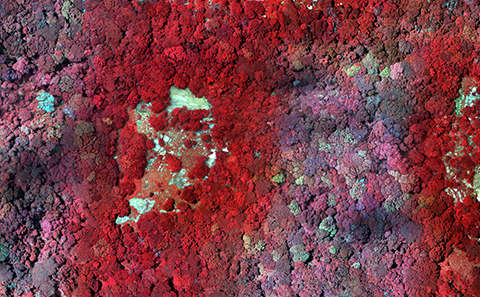If you think it’s rough out there for single folks, consider the case of E. woodii. Scientists have only ever discovered one example of the plant species — a male eking out a lonely existence in South Africa’s Ngoye Forest, in 1895.
That specimen was quickly moved to a botanical garden, where botanists have managed to propagate it over the last century. But now researchers using modern tools are scouring the forest for a potential mate. Think of it as Tinder for, well, tinder.

Dr. Laura Cinti next to the E. woodii at a botanical garden. Photo: University of Southampton
“This plant is, as far as we know, extinct in the wild. I was very inspired by the story of the E. woodii, it mirrors a classic tale of unrequited love. I’m hopeful there is a female out there somewhere, after all, there must have been at one time,” said Dr. Laura Cinti, a research fellow at the University of Southampton’s Winchester School of Art, in a statement.
Cinti is leading a team of scientists using drones and artificial intelligence (AI) to scour the dense 4,000-hectare Ngoye Forest for a possible mate for the plant.
“It would be amazing to bring this plant so close to extinction back through natural reproduction,” she continued.
A long, lonely, lonely, lonely, lonely, time
E. woodii is a cycad, the oldest seed-bearing type of plant still living on the planet today. Cycads first arrived on the scene 300 million years ago, meaning they’ve survived the extinction event that killed the dinosaurs, the Industrial Revolution, and the 1980s, among other planetary calamities.
All cycads are rare. In fact, they are the most endangered organisms on Earth, and are kept in cages in botanical gardens so that thieves don’t sell them on the black market. But E. woodii is rare even by cycad standards.
And after drones took tens of thousands of multispectral images in 2022 without turning up another example of the species, Cinti and her team turned to AI to help shorten the search.

One of the multi-spectral images created by drones and now being analyzed by AI. Photo: C-LAB
“With the AI, we are using an image recognition algorithm in order to recognize plants by shape,” she said “We generated images of plants and put them in different ecological settings to train the model to recognize them.”
And if that doesn’t work? The team has a plan B — change E. woodii’s sex.
“There have been reports of sex change in other cycad species due to sudden environmental changes such as temperature, so we are hopeful we can induce sex change in the E. woodii too,” Cinti explained.
Good luck, E. woodii. We’re all — ahem — rooting for you.






